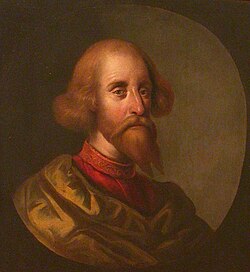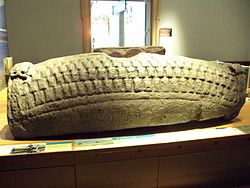Culen of Scotland
Cuilén mac Illuilb (Modern Gaelic: Chailein mac Ilduilb; 6 April 934 — 2 June 971) often known as Culen and nicknamed the Smart (Scottish Gaelic: an Smart), the Brave (Scottish Gaelic: an Treun) or the Strong (Scottish Gaelic: an Làidir) was the King of Scotland from 967 until his death in 971. He was the son of King Indulf (Illuilb mac Causantín). His mother was unknown but it was said that she was from France.
| Culen | |
|---|---|

| |
| Posthumous painting by Jacob de Wet II, c. 1685 | |
| King of Scots | |
| Reign | 20 July 967 — 2 June 971 |
| Coronation | 26 July 967 |
| Predecessor | Dub |
| Successor | Kenneth II (or Amlaíb, disputed) |
| Issue | |
| House | Alpin |
| Father | Indulf of Scotland |
| Religion | Roman Catholicism |
It was said that he would spend his reign focusing on kicking the vikings out of Scotland and to expand Scotland. When Culen died in 971, the throne was disputed between his younger brother who was his heir, Amlaíb, and his cousin, Kenneth II (Cináeda mac Maíl Coluim). Because Kenneth was more experienced than Amlaíb, he seized the throne for himself. Culen's son, Causantín, would succeded Kenneth II as king as Constantine III after Kenneth's death in 995.
Culen Of Scotland Media
Cuilén's name as it appears on folio 29v of Paris Bibliothèque Nationale MS Latin 4126 (the Poppleton manuscript): "Culenrīg". The word might include an epithet at the end, or may be corrupted from a copying error.
The name of Cuilén's rival kinsman, Dub mac Maíl Choluim, as it appears on folio 32v of Oxford Bodleian Library MS Rawlinson B 489.
Detail of inscriptions upon Sueno's Stone which may represent Dub's demise. The visible arch could represent a bridge, and the framed head under the arch may represent Dub, whose body was traditionally said to have been hidden beneath a bridge.
The name of Cuilén's brother, Amlaíb mac Illuilb, as it appears on folio 15r of Oxford Bodleian Library MS Rawlinson B 488 (the Annals of Tigernach): "Amlaim mac Illuilb". Amlaíb seems to have held the kingship between 971–976, 977.
The name of Cuilén's killer, Rhydderch ap Dyfnwal, as it appears on folio 8v of British Library Cotton MS Faustina B IX (the Chronicle of Melrose): "Radhardus".
The name of Cuilén's successor, Cináed mac Maíl Choluim, as it appears on folio 15r of Oxford Bodleian Library MS Rawlinson B 488: "Cinaeth mac Mail Cholaim".
The name of Cuilén's son, Custantín mac Cuiléin, as it appears on folio 15v of Oxford Bodleian Library MS Rawlinson B 488: "Constantin mac Cuilindaín".
The title accorded to Cuilén on folio 33r of Oxford Bodleian Library MS Rawlinson B 489. Cuilén's patrilineal ancestor Áed mac Cináeda – eponym of Clann Áed meic Cináeda – is the last king to be accorded the Latin title rex Pictorum ("king of the Picts"). Scottish kings were afterwards styled in Gaelic rí Alban ("king of Alba").
A hogback grave slab on display in Glasgow. Such monuments may be indicative of Scandinavian settlement in Perthshire and Fife. The aforesaid evidence of Scandinavian influence upon Cuilén's immediate family could indicate that his kindred was involved with such immigration.






